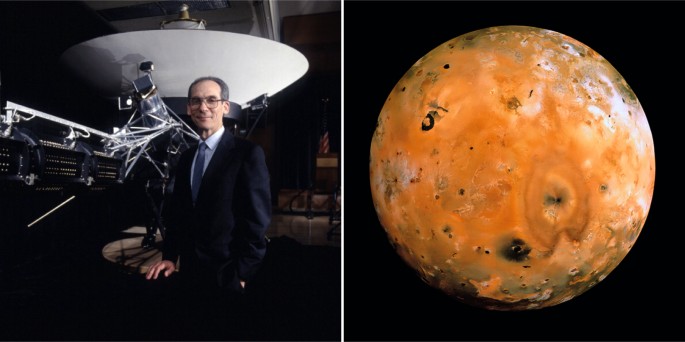Forty years ago, the two Voyager spacecraft left Earth to begin one of the most rewarding voyages of human discovery ever to have been undertaken. Project Scientist Ed Stone recounts his treasured moments from the mission.
Two Voyager spacecraft were launched on humankind’s longest journeys in 1977. At that time, Jupiter, Saturn, Uranus and Neptune were lined up so that the gravity assist of each planetary flyby could serve as a slingshot to speed a spacecraft on its way past all four giant planets in just 12 years rather than 30. This special planetary alignment occurs only every 176 years, and Gary Flandro, a Caltech graduate student working at NASA’s Jet Propulsion Laboratory (JPL) in the summer of 1965, found that the outer planets would align in the late 1970s. This led to a decade of planning and construction that eventually culminated in two Mini Cooper-sized spacecraft being launched into the Solar System: Voyager 2 on 20 August 1977 and Voyager 1 two weeks later.
The planetary encounters were the highlights for me personally as Voyager project scientist (Fig. 1, left). We knew we were on unequalled journeys of discovery, and every day we saw and learned new things. Between the two Voyagers, we had six planetary encounters (Voyager 2 visited all four giant planets, whereas Voyager 1 visited only Jupiter and Saturn). We developed a daily routine to take the public along on the encounters nearly in real time, before there was an Internet. The science team would meet early each afternoon to discuss the latest observations and various explanations and interpretations of the data. This process was a form of real-time peer review, which was very exciting. Once the meeting ended, I would meet with the lead investigators to decide what graphics to develop overnight for release during the press conference the following morning. At the same time, the imaging team would choose images for the overnight production of prints for distribution to the media present at the press conference. At 10:00 the next morning we would present our results to the reporters gathered at JPL. We would then start the cycle again with another science meeting that afternoon.
Among all of the wonders that the Voyagers have shown us, if I had to pick one of those that greatly astonished me and signalled a transformation of our perspective of the Solar System, it was the discovery of eight active volcanoes on Jupiter’s moon Io. Linda Morabito, an optical navigator, had spotted something unusual while looking through images showing the position of Io with respect to background stars. It was 9 March 1979, the final scheduled press conference for the Jupiter encounter had already taken place the day before, and I remember it being a quiet Friday afternoon at JPL. But then Andy Collins from the imaging team told me “you’ve got to see this’’. We went to see Linda and saw Io with a protruding feature that could only be a volcanic plume extending more than one hundred miles above the surface.
This was the first time we had direct evidence of active volcanoes existing anywhere other than on Earth. Jupiter’s moon Io (Fig. 1, right) is much smaller than Earth, but its volcanic activity is ten times greater. This surprise from the first Voyager encounter serves as a bookend for the many unexpected planetary discoveries that culminated with Neptune’s moon Triton, the other bookend. Our last planetary close-up view revealed that Triton has two active geysers erupting from an icy surface that is only 38 degrees above absolute zero.
Following the Voyager 2 flyby of Neptune and Triton in 1989, the final portrait of the Solar System and the 'pale blue dot' photograph by Voyager 1 in 1990, the Voyagers continued their journeys to the edge of the heliospheric bubble that envelops the Sun and all of the planets. Outside the bubble lies interstellar space, containing matter from supernovae that exploded millions of years ago. The distance to the boundary of the heliosphere was unknown and we did not know if Voyager 1 would still be operating when it entered interstellar space. Fortunately, the boundary was close enough for us to observe it. On 25 August 2012, after a 35-year journey, Voyager 1 became the first human made object to enter interstellar space. In a few years, Voyager 2 will join Voyager 1 in exploring nearby interstellar space. As they near the end of their operational life, we will begin to power down heaters and instruments as the electrical power source continues its slow decline.
When there is no longer enough power for the spacecraft, the two Voyagers will be our silent ambassadors, orbiting the centre of the Milky Way every 225 million years for billions of years and carrying golden records that are time capsules of the world that launched them on their epic journeys. Their success is due to exceptional engineering, transformative science and extraordinary inspiration. For many of us it has been the journey of a lifetime.
Author information
Authors and Affiliations
Corresponding author
Rights and permissions
About this article
Cite this article
Stone, E. The Voyagers. Nat Astron 1, 896 (2017). https://doi.org/10.1038/s41550-017-0339-2
Published:
Issue Date:
DOI: https://doi.org/10.1038/s41550-017-0339-2
This article is cited by
-
Solar system exploration via comparative planetology
Nature Communications (2020)

